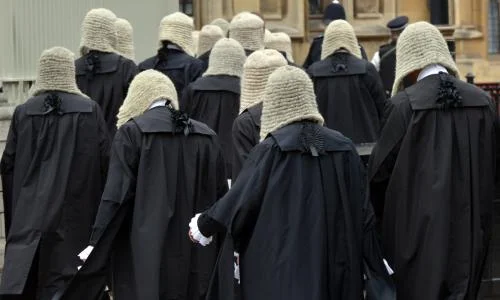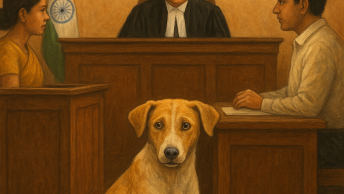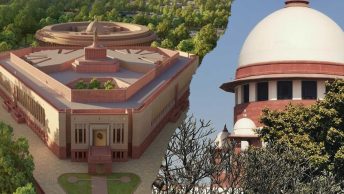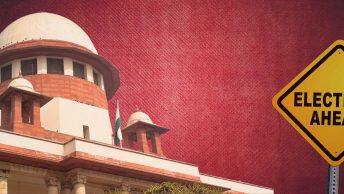This blog post replies to Sarthak Sahoo’s claim against intellectual bias as a ground of recusal. The author provides a rejoinder to his arguments while simultaneously revisiting his earlier understanding and interpretation of the prevalent intellectual prejudices within the Indian judicial system.
Bias and prejudice, rarely are overt, conscious or deliberate but instead are extremely subtle, unconscious, and naïve. The judicial system while over the years has actively attempted to eliminate any kind of prejudiced messages, behaviors, and attitudes, has been ignorant towards the inclusion of certain biased intellectual predispositions which attack both the fairness and the equality element of our nation’s courts.
In an earlier work, I had highlighted the absence of consideration of intellectual biases by judges when recusing from certain cases. I had defined intellectual biases to mean staunch and fixated opinions. Building on this, I had further contended that a judge should recuse based on the ground of intellectual bias, if she has in any previous case or a reference order expressed pre-conceived notions and views about the impugned interpretation. Thus, diluting the standard of bias to a great extent. Against this conclusion, it has been argued by Sahoo that the ground of ‘intellectual bias’ in itself is a “positively dangerous one for a common law judiciary”. Through this post, I seek to defend my earlier observations while simultaneously presenting a reply to the constructive and timely arguments raised against judicial bias.
The Proposed Reference Rule: Revisited
Several cases over the years, have led to the understanding, refinement and subsequent interpretation of the meaning of the term – ‘intellectual bias’. Rather than understanding them to be mere predispositions as argued by Sahoo, I contend that the assumption of prejudice continues to hold immense importance in contemporary adjudication. If a judge has previously ‘expressed an opinion’ about an interpretation of a case, she must not be allowed to adjudicate the veracity of the exact same interpretation.
The arguments against the intellectual bias ground as claimed by Sahoo make it clear, that it is imperative to alleviate the confusion and clarify what does ‘expressed an opinion’ practically mean. In this very specific context, it could mean that the judge has already adjudicated upon and formally mentioned their opinion or observation either in an order/judgment, or informally observed it during the proceedings. The opinion could range from: first, the legality of the statutory provisions; to second, the constitutionality of any provision or amendment; or third, the meaning of specific terms in the statute that are contested.
For illustration, if Judge A in the Calcutta High Court has held that Section 72 of the IT Act was unconstitutional, she should not be allowed to adjudicate on the constitutionality of it when it is either appealed in the Division Bench or in the Supreme Court (assuming she is elevated). Additionally, it should be specifically followed by the Chief Justice when forming larger constitutional benches to provide finality to the legality of Section 72. Herein, it becomes imperative to clarify that not only are referee judges being disqualified but also any judge that has expressed an opinion on the ‘legality of Section 72 of the IT Act’. In the following part, I seek to tackle some of the counter-arguments that have been made both by Sarthak and several other commentators.
The Second Side To The Coin
The most common opposition to this understanding of intellectual bias has always been that it is possible that every judge either in the High Court or the Supreme Court would have expressed an opinion on an interpretation of a statute or a constitutional provision, one way or the other. Similarly, Sahoo claims that judicial disqualification based on the proposed reference rule as calibrated above will be “too cumbersome to be a practical policy consideration”. Thus, Sahoo states that instead we must impose faith in a judge who has sworn to perform their judicial duties, maintain the judicial form, and uphold the majesty of justice.
At the outset, I oppose Sahoo’s naïve belief in the Indian justice system. Professor Dam’s empirical and in-depth research on judicial corruption in India, specifically in the Supreme Court makes me wary in imposing any faith in any judge of the highest Court of the country.
Thus, I argue that the proposed reference rule is extremely nuanced and has been narrowly constructed which opposes alleged cumbersome policy considerations. It becomes imperative to note that the rule does not indicate the inclusion of general interpretations. I acknowledge that a judge in her tenure would have for instance, would have used Article 21, Article 14 or Article 19 of the Indian Constitution. The rule does not translate to eliminating her from all cases where there have been alleged violations of these provisions. However, the rule would ask for the judge’s elimination if she has expressed an opinion on whether freedom of speech and expression constitutes freedom of internet under Article 19. Thus, the reference rule tracks the shift from general interpretations to specific ones and seeks to provide stiff resistance to the latter. Moreover, it is preposterous to think that all 34 judges of the Apex Court have in their tenures decided on such specific interpretations.
While it can be counter-argued that the line between general and specific interpretations might blur in several cases. In response, I contend that in cases where the lines would blur, it would only be correct to recuse the judge rather than keeping them on the bench. The emphasis must not only be on the possibility of bias but also on the probability of prejudice. Hence, all possible attempts must be made to secure the right to a fair trial and an unbiased bench.
Sahoo on the other hand, opposes the proposed reference rule in claiming that a judge can always have her mind changed by the lawyers since first, when a judge is considering the validity of a provision, she is considering them de novo and not being influenced by precedents; second, that referring judges might be a part of a larger bench where senior judges preside (who were not referring judges earlier) and thus, polyvocality of the Apex Court might not be in play here; and third, that an appropriate burden exists on the lawyer while arguing in front of a referee judge that was also the referring judge.
Firstly, I argue that Sahoo’s claim that the “presence of common law precedents is a non-sequitur to the question of intellectual bias” is misplaced in the larger context of recusal frameworks. The argument of court being likely to follow precedents was made solely to indicate the burden on a lawyer. A lawyer who while arguing the need to move away from a precedent, needs to push a bit stronger since the Court being based in a common law country is ‘more likely’ to stick to earlier precedent. For instance, in Waman Rao, the Court reminded itself to “stand by its decisions and not to disturb what is settled.” The burden on a lawyer thus increases if it comes across a judge who is not only reminded to not disturb what is settled but also is already inclined towards a particular interpretation of law.
Thus, while Sahoo’s claim might be correct, it seems incredibly misplaced since the above argument sought to merely question the efficacy of the safeguard by highlighting the presence of an additional burden. Similarly, Sahoo’s third claim as depicted above becomes unconvincing since it can be showcased that the burden on a lawyer has unfairly been heightened by the presence of a judge who is intellectually biased towards a particular interpretation of the law. This is not the original burden which has to be discharged, but an unwarranted and prejudiced burden which has been thrusted on her.
Secondly, I acknowledge Sahoo’s claim that in some cases senior judges might be appointed along with the referring judges, rendering the question of seniority redundant. He offers the case of Jaishri Laxmanrao Patil as an example. I contend that while such a possibility might be absolutely correct, the composition of a bench must be viewed contextually. In Jaishri Patil, it could be seen that there were three judges which referred the matter (Justice Rao, Justice Gupta, and Justice Bhat) whereas in the larger bench constituted – Justice Bhushan and Justice Nazeer were added. Thus, while Justice Bhushan was senior to all the other judges and could have a different view point, three referee judges that were referring judges and assuming were intellectually biased could in fact numerically sway the ruling of the case in a five-judge bench. Thus, not just seniority but contextually even the number of biased referring judges’ matter.
This argument however should not in any way dilute the senior-junior dominance malady. It is not quite surprising that in all the cases wherein it was showcased that a judge on a smaller bench changed their opinion when placed on a larger bench (as depicted in the Manohar Lal case) were in fact, junior referring judges that in turn became junior referee judges and were one of a larger five/seven-judge bench (i.e., Justice Bhagwati in Gyan Devi Anand v. Jeevan Kumar and in Distributors (Baroda) Pvt. Ltd. v. Union of India; Justice Bharucha in Hyderabad Industries Limited v. Union of India; Justice Hidyatullah in Keshav Mills Co. Ltd. v. Commissioner of Income Tax; Justice Mukherji in Ujagar Prints (II) v. Union of India). Hence, it can be speculated that the reason of changing the view of the numerically singular and junior referring judge could be the dominance of senior judges.
Lastly, Sahoo contends that intellectual bias is nothing but opinion and further posits two questions that I seek to answer: (a) “It is routine for judges to have authored academic articles, or delivered lectures on particular provisions of legislation. Should that mean they are indisposed to be decide any particular way when that provision is put into effect?” and (b) “What similarly can be said of opinions extrapolated in academic materials? Would that mean that any judge having expressed any view in a scholarly role is precluded from hearing any case on that issue?”
I answer both the questions posed by Sahoo in the affirmative. A judge who showcases her inclination and comments (either positively or negatively) on particular provisions of legislation depicts bias and ought to recuse. Similarly, opinions extrapolated in academic articles and scholarly publications, while laudatory, clearly indicate the presence of bias. This exact thought was kept in mind while the Restatement of Values of Judicial Life was unanimously adopted by the Supreme Court way back in 1997. Principle 8 adopted is self-explanatory and clearly states that a judge shall not enter into a public debate or express views in public or political matters that are pending or are likely to appear for judicial determination. Judges are well-aware that provisions might be challenged and thus, must not either caution compliance or advocate friendlier legal frameworks in any circumstance whatsoever. Additionally, Principle 9 states that a judge is expected to only let her judgments speaks for themselves and not participate in any interview regarding the interpretation of the same. Thus, overall, it can be seen that there is an embargo for judges to lay down their thoughts about statutes, bills, or amendments in the public domain. A judge in her infinite wisdom is solely supposed to look at the lis, examine the precedents, hear the arguments, and decide the case without any pre-expressed inclinations or tendencies. This would truly emulate a fair trial along with an unbiased bench.
While Principle 1 is known all over the world – “Justice must not merely be done but it must also be seen to be done”, it is imperative to emphasize and re-iterate the same. As a litigant, you will reasonably believe that the trial is unfair because the judge that is adjudicating the same has given a lecture, agreeing with the other side. While it can be counter-argued that the judge can change her views. I argue that irrespective of the end (which may or may not take place), the means are important. From the moment, the judge who has expressed a proclivity for a particular interpretation hears a case, the proceeding is not only tainted but also violates constitutional rights of a fair trial under Article 21.
While Justice Mishra seemed to believe that – “It may also work to the advantage of all concerned if a Judge having decided the matter either way is also a member of the larger bench.” I question whether the same is an advantage or is it a façade for intellectual bias, judicial prejudices and constitutional violations to seep in. I had ended my earlier blog-post (on the illegal composition of the Asian Resurfacing case) with a vision and a foresight that has been proved right. It is absolutely not surprising that the earlier judgment has been over-ruled by a bench of judges that were in fact, intellectually biased. Intellectual bias hence, is not just mere dogmas or thoughts or opinions, but in fact is judicial prejudice which warrants disqualification.
Anshul is currently a Research Fellow at the Center for Constitutional Law. He pursued postgraduate degree from the University of Oxford and undergraduate degree from NUJS, Kolkata. He is passionate about public law, especially its intersection with the Constitution.
Ed Note: This article has been edited by Jeetendra Vishwakarma and published by Abhishek Sanjay from the Student Editorial Board.







[…] Posted byAnshul Dalmia […]